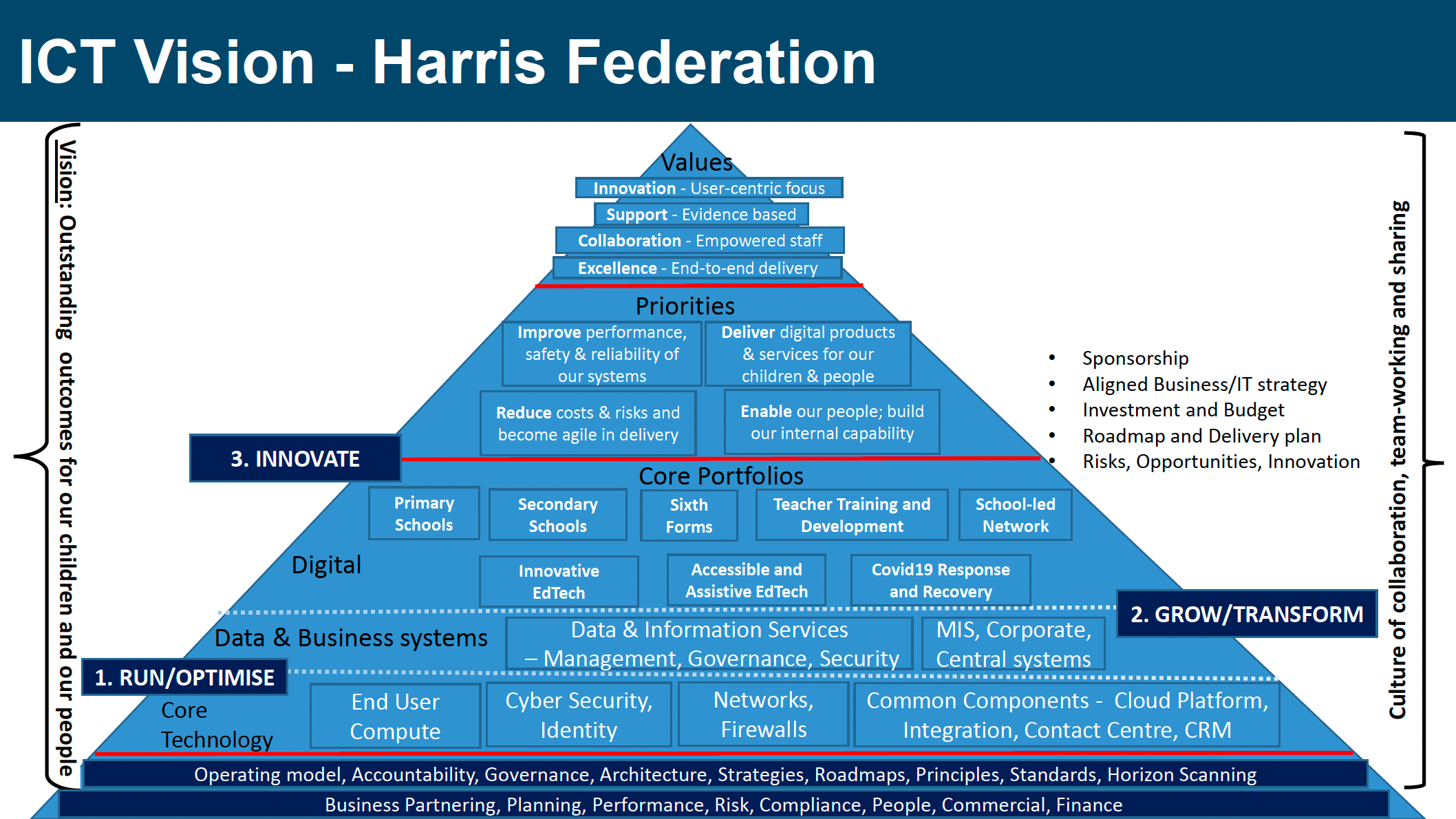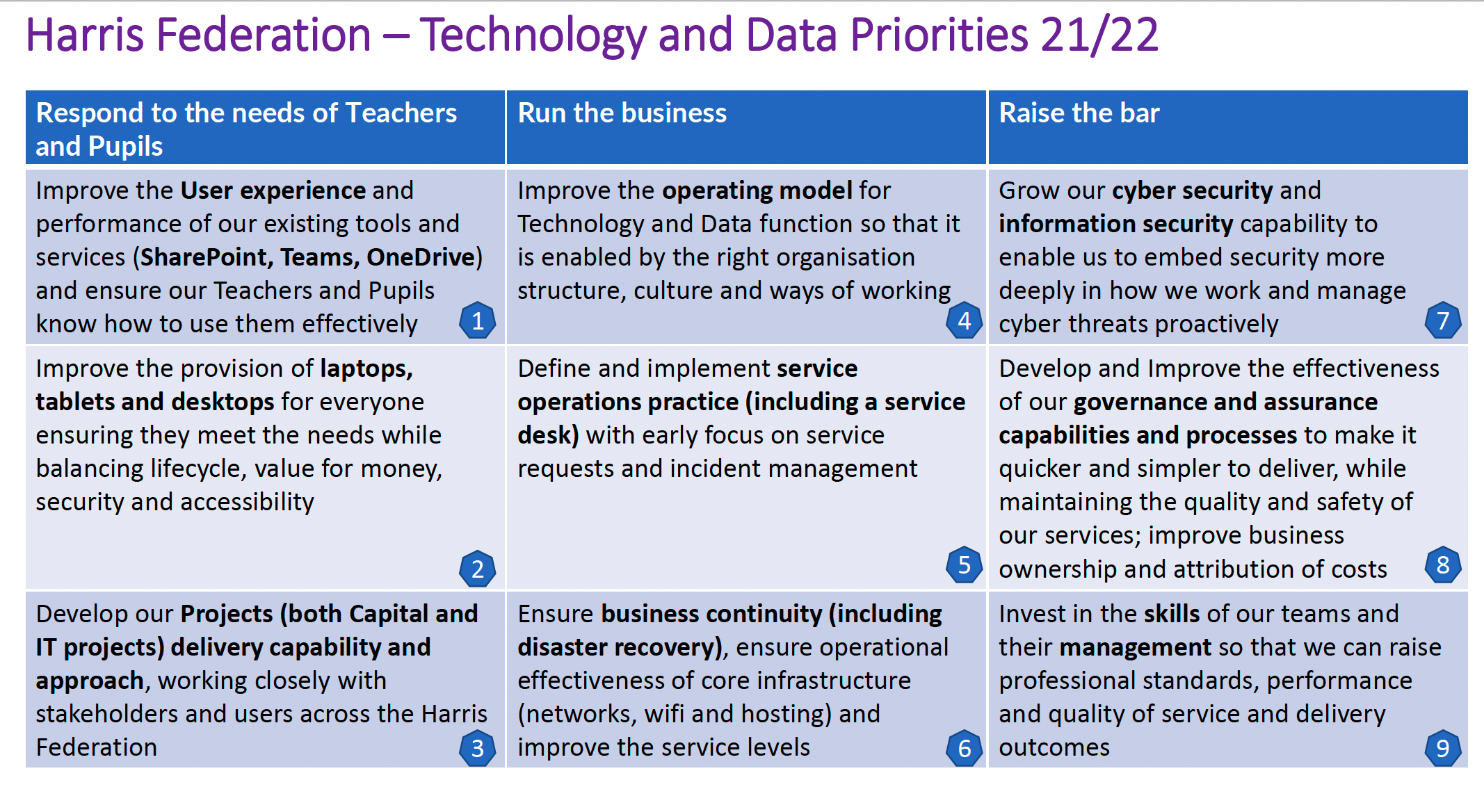Petko et al (2015) provide an excellent paper on suggesting a top-down and bottom-up process of digital media adoption to be the most successful as compared to a) top-down b)bottom-up c) optional. In my organisation this is done by the following:
- Input from the Primary IT group – composed of Executive principals, IT Services, Chief Information Officer
- Input from the Secondary IT group- composed of Executive principals, IT Services, Chief Information Officer
- Immediate need to resolve IT issues around SharePoint being functional and not causing staff frustration as a priority
- Strategic direction from Digital Learning Lead, Chief Information Officer with approval by Executive Principals who oversee clusters of schools.
- Input from school visits and meetings curriculum leads and senior managers by Digital Learning Lead and Chief Information Officer
- Input from Harris Federation subject specialise consultants who work closely with school subject coordinators to offer support
Some conflicting issues between ‘structure’ and ‘agency’, which have arisen in such forums include:
- Beliefs about ‘what is possible with the effective use of EdTech particularly in the primary area key stage 1 and 2. Also, staff who have worked within the Federation since the Microsoft eco-system was developed (10 years ago) may not be aware of effective practices. To help resolve this, demonstrations from other MATs and LMS/MS 0365 providers to the IT groups is helping in encouraging a more holistic solution to the growing frustrations of staff around SharePoint.
- Some schools have created their own systems around other eco-systems or technologies including Apple, Google and iPads which will need to be factored in when balancing the pros and cons of diversity vs practicality of support, developments and structural design of a single eco-system
- Identifying drivers for change: (Systemness) educational solution as opposed to a (Fragmented) IT solution (Fullan, 2021).
From an IT perspective the priority is seen around cost savings, support and security; the suggested development proposed is for
- Higher a SharePoint consultant/developer
- Third-party to provide CPD
- Project to be divided into 2 strands:
- file storage and then as a second iteration
- teaching, learning and assessment use of MS 0365 (later development)
The above developmental model was challenged with a holistic educational model in which ‘Systemness’ was a key driver (Fullan, 2021); file storage structures and systems are seen as an integral part of the way education happens.
Fig 1.

The notion of EdTech being primarily about ‘innovation’ involving ‘accessible and assistive’ technologies was challenged with the suggestion that EdTech could also inform the design and planning of the foundation/core ICT infrastructure for greater user adoption and impact. As opposed to seeing the project as one driven by ‘structure’ (of upgrading and improving the IT infrastructure), it can also be viewed primarily rooted in cultural change, process optimisation and adding meaningful pedagogical value. Singh and Hardaker (2017) reference Gidden (1984) with the concept of ‘structure’ and ‘agency’ not as ‘independent or incompatible, but as mutually interacting elements of a duality’. It could however be argued, that beyond the ‘interaction’ one plays the role of a driver, either intentionally (in order to resolve an IT issue, IT being the driver) or as I am suggesting through a Digital Education Strategy, by design in which the IT issues resolved while also allowing ‘agency’ and pedagogy to shape the design and solution of the system change (Fullan, 2021)
A single partner solution was therefore proposed who can offer:
- Infrastructure development includes a user-friendly interface for the educational user (Bayne et al., 2020)
- Continued Professional Development & digital certification – intrinsic driver (Singh and Hardaker, 2017)
- Ongoing support for both IT and curriculum leads
- User adoption and implementation strategy
- A scalable solution for a Multi-Academy Trust of 50 schools allowing local decision making on managing the product as opposed to reliance on computing team at Head Office
- MS 0365 linked to pedagogical usage and outcomes (Education Endowment Fund, 2019)
In such a case, roles to sustain and manage the change would need to be considered from Digital Leads (SLT) in schools who may wish to have staff Digital Champions who can develop the technical, knowledge and pedagogical expertise (Chai and Koh, 2017), as part of their continued professional development; something Singh and Hardaker (2017) concluded as being a key change level in unifying top-down and bottom-up approaches. From a Trust level, support in developing a school digital education strategy at the school level would need to be considered. Also, consideration would need to be given to school autonomy in using alternative MS0365 Learning Management Systems (e.g. Skooler, Firefly, Canvas) further down the line and therefore agility would need to be part of the infrastructure design.
Launch of #minecraft coding at two Peckham Primary schools today @HPFSP @HPAPPeckhamPark @HarrisFed @MSEducationUK @Jenking__ @ssafdar314 pic.twitter.com/iViPwE7TzT
— HF_EdTech (@HF_EdTech) November 29, 2021
Despite the security attack and frustrations around SharePoint set-up, discussions around pedagogical lead initiatives are still taking place with certain ‘early adopters’ and Harris Federation subject consultant teams who support schools. Minecraft Education Edition is seen as a priority in two primary schools (HF_EdTech, 2021). This would drive some of the IT strategy choices over-specification of student devices for example.

On a more macro-Trust level, in order to maximise interaction and close the gap between ‘agency’ and ‘structure’ (Singh and Hardaker, 2017), connections would need to be made where possible, to the nine points of the Technology and Data Priorities 21/22, as proposed by the Chief Information Officer, which currently is the key driver for change given the staff frustrations with the current ICT infrastructure.
References
Bayne, S. et al. (2020) The Manifesto for Teaching Online. Cambridge: MIT Press, The MIT Press (The MIT Press).
Chai, C.S. and Koh, J.H.L. (2017) ‘Changing teachers’ TPACK and design beliefs through the Scaffolded TPACK Lesson Design Model (STLDM)’, Learning: Research and Practice, 3(2), pp. 114–129. doi:10.1080/23735082.2017.1360506.
Education Endowment Fund (2019) Using Digital Technology to Improve Learning, EEF. Available at: https://educationendowmentfoundation.org.uk/education-evidence/guidance-reports/digital (Accessed: 7 November 2021).
Fullan (2021) The Right Drivers for Whole System Success – Michael Fullan. Available at: https://michaelfullan.ca/3460-2/ (Accessed: 9 October 2021).
HF_EdTech (2021) ‘Launch of #minecraft coding at two Peckham Primary schools today @HPFSP @HPAPPeckhamPark @HarrisFed @MSEducationUK @Jenking__ @ssafdar314 https://t.co/iViPwE7TzT’, @HF_EdTech, 29 November. Available at: https://twitter.com/HF_EdTech/status/1465383711617306634 (Accessed: 4 December 2021).
Singh, G. and Hardaker, G. (2017) ‘Change levers for unifying top-down and bottom-up approaches to the adoption and diffusion of e-learning in higher education’, Teaching in Higher Education, 22(6), pp. 736–748. doi:10.1080/13562517.2017.1289508.



